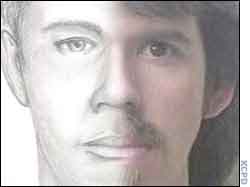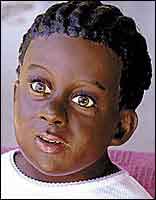Featuring E.D.A.N. [ Everyone Deserves A Name] part of the DoeNetwork Organization:
BY Matt Bean
Court TV
July, 2003

It might be a sculpture or a rough pencil-sketch, but an artist's reconstruction of a John or Jane Doe's face may be the last time they're brought to life, if only in clay or on paper.
It's also often the best chance they have of reclaiming their lost identity: Such sketches and busts of missing and unidentified persons are often a last resort when leads have thinned, when witnesses have failed to come forward, and when the Doe's body is decomposed and does not bear enough identifying details to match a missing person somewhere.
But the question is, are they good enough?
That's something that Todd Matthews, a Tennessee man who has dedicated himself to matching murdered John and Jane Does with their lost identities, sought to answer one night this June when he showed his mother a sketch, as he often does.
"Recognize anything?" her son, Todd Matthews, asked. "Does this person look like anyone you know, living or dead?"
"No," said his mother, Brenda, shaking her head. "I don't recognize this person."
This time, the subject was closer to home than usual: Todd, who works with the volunteer group The Doe Network, was holding a sketch of himself, drawn from an X-ray by a prominent police artist.
"She watched me grow, she watched me change, and she couldn't even recognize it," said Matthews, 33. "That proves a point. The sketch probably could have hindered my identification."
Brenda Matthews' inability to identify her own son reveals one of the nagging limitations facing the facial identity community. Statistics on the success of police sketches are hard to come by. But there are almost 5,000 John and Jane Does now in the FBI's National Crime Information Center database, and reconstructions—one of the primary vehicles investigators have for solving the toughest cases—still depend on a bit of educated guesswork.
There's nothing wrong with the art, however, and that's why Matthews and others investigators and scientists are working to make Doe sketches and sculptures more precise. They're upgrading the data artists use to craft the reconstructions, applying Hollywood special effects techniques to make the creation faster and more flexible, and even seeking to change the way the public views the images.
Another try for Precious Doe
It's been two years now since Precious Doe was found, two years since the young girl between 3 and 6 years of age was beheaded and dumped outside of Kansas City, Mo. in a wooded area near the local zoo.
Though badly decomposed, her skull, which was found nearby, still carried the neat cornrows she had worn in life. That skull, investigators are hoping, could still prove the key to unlocking her identity.

Whereas police sketch artists often compile portraits from a laundry list of features — the type of nose, mouth, hair — artists who render the unknown dead in three dimensional busts typically work from the inside out, envisioning how muscles, tendons, fat and skin all sit together on a foundation of bone.
Tissue depth charts tailored to ethnicity, age and weight can help determine the rough structure of the Doe's head, but the fine shape of the face, which can be crucial for sparking recognition in a family member, friend or witness, is largely left to the artist's intuition.
That's the process that yielded the first sketch and clay bust of the Precious Doe. But none of the more than 1,000 leads panned out, and by 2003, the Doe's case had grown cold.
This July, however, the search for Precious Doe's identity was revived, in part because of the promise of a new effort from a pioneering Louisiana reconstruction laboratory armed with pinpoint data on tissue depths for black children.
"I still believe somebody out there somewhere knows this child," said Sergeant David Bernard of the KCPD. Bernard and his team have been frustrated by a series of near-matches, but remain hopeful that this reconstruction will trigger a recollection in the right person. "We'll keep going until we find the right one," he said.
At Louisiana State University's Forensic Anthropology and Computer Enhancement Services lab, or FACES, forensic anthropologist Mary Manhein uses computer animation techniques and engineering software that would normally be too expensive for police to wield themselves.
On July 14, Manhein flew to Kansas City for the exhumation of Precious Doe, and carried her skull back to her Louisiana lab to begin the analysis.
Manhein first scanned the exterior of the skull with lasers to produce a 3-D model in plastic resin. That model will serve as a framework for her artist, Eileen Barrow, who will apply clay to flesh out the model.
"This will be the fourth and, we hope, last image made of Precious Doe," said Manhein.
Barrow will have a lot more than just the model of the skull to work from. Manhein's lab, which has produced more than 40 reproductions, has researched tissue depth markers to more accurately gauge the skin contours that determine the person's outward appearance. Forensic artists rely heavily on tissue depth charts for clues on how the musculature and other tissues affect the surface structure of someone's face.
The set of data Manhein plans to apply to Precious Doe is the most comprehensive tissue depth database of its kind in the country. Taken with ultrasound tools from almost 1,000 black children, it marks a shift in the way that such data are collected.
Tissue depths were once harvested solely from cadavers, and in fact many of the most popular data sets still rely on those antiquated measurements.
Tissue depth sets are now being taken from volunteers using sophisticated medical techniques, however, and the subtle differences in skin tension and gravity that result from having a living, standing subject can make all the difference in a Doe's reconstructed appearance.
Not only is the data becoming more precise, researchers like Manhein are also tailoring it to particular ethnicities and ages. Most victims, including Precious Doe, can be placed in a particular group through flesh remaining on the skeleton or through DNA and dental records. The more precise the data, the more accurate the reproduction.
"Without those depths you're just applying clay onto a structure, you're blind," said Barbara Martin, a forensic artist with the Oakland County Sheriff's Department in Michigan. "Leonardo, Michelangelo and DaVinci did studies on how veins and muscles and flesh tie together across the structures. They managed to breathe life back into the face. And that's exactly what we try to do."
John and Jane Doe Go Hollywood
Sketching and sculpting has largely remained the same since Renaissance days, but a pioneering British lab is working to give facial reconstruction a 21st-century makeover.
"Instead of modeling muscles in clay we model them by computer, in virtual reality," said Martin Evison, a senior lecturer in forensic and biological anthropology at Sheffield College in England. "The artistic skills are the same, but the artist works with a computer, keyboard, and tablet rather than with a bag of clay."

Age-progression
After scanning a skull much like the FACES lab does, Evison uses his proprietary software program to digitally re-create the detailed cranio-facial anatomy, from tendons all the way up to the skin, hair, and eyes. He can then morph the computer portrait through different age progressions, different weight levels, and can even blend tissue depth data to accommodate Does with mixed racial ancestry.
The goal: Showing potential family members and acquaintances a range of versions, hoping that one will click.
Other computer systems, including one used by the National Center for Missing and Exploited Children, work in two dimensions, "connecting the dots" by matching tissue depth data to a database of images.
Evison's team has worked since the mid-90s to construct a flexible system that takes advantage of the same commercial modeling systems that are industry-standard software for rendering three-dimensional architectural structures and movie special effects. The group is also seeking to distribute the fully rotatable images via the Internet.
Their results only stand to improve: This year, the Royal Society of London presented Evison's lab with a grant to use magnetic resonance imaging, or MRI, to collect even more data on living volunteers. The whole system should be up and running—and available for police departments around the world—in two or three years, Evison says.
Bridging the Gap: Helping People See the Doe
Digital or not, Doe reconstructions can easily end up looking stilted or, at the very least, unfamiliar. "You have a certain amount of artistic license," said Martin, who has been sculpting faces for 35 years. "You try to make sure it doesn't look like a mannequin. That could be relaxing an eyelid or the corner of the mouth."
Sketch artists stress that their images are anything but portraits of the Doe. But Doe crusader Todd Matthews believes the images could still spark recognition, and has started an initiative as part of his project EDAN (Everyone Deserves a Name) to teach people to look at sketches and sculptures more carefully.
"Never skip over a case because the sketch isn't a dead ringer," he advises anyone who might have knowledge of a missing person.
Matthews wants to teach the public to look at Doe sketches and busts more effectively—getting them to focus on features less open to artistic interpretation, like the brow, the bridge of the nose, and the cheekbones.
"There's thousands of missing people out there," he said. "There's no doubt about it, it's going to touch your life. Everybody's a potential witness."